snow chains AUDI RS7 SPORTBACK 2016 Owners Manual
[x] Cancel search | Manufacturer: AUDI, Model Year: 2016, Model line: RS7 SPORTBACK, Model: AUDI RS7 SPORTBACK 2016Pages: 282, PDF Size: 70.78 MB
Page 109 of 282
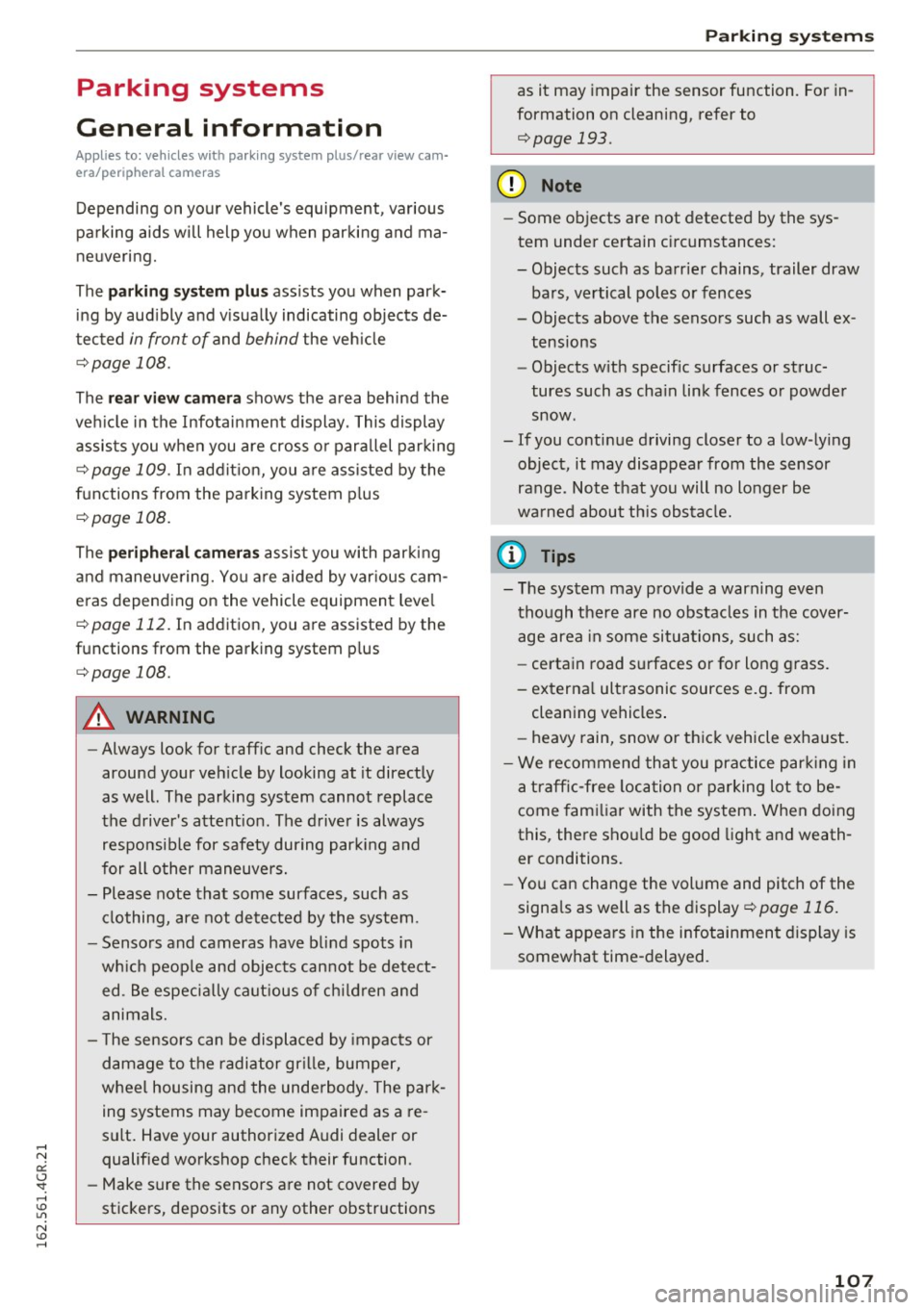
Parking systems
General information
Applies to: vehicl es with parking system plus/rear view cam
era/peripheral cameras
Depending on your vehicle's equipment, various
parking aids will help you when parking and ma
neuvering.
The
parking system plus assists you when park
ing by audibly and visually indicating objects de
tected
in front of and behind the vehicle
¢page 108.
The rear view camera shows the area behind the
vehicle in the Infotainment display. This display
assists you when you are cross or parallel parking
¢ page 109. In addition, you are assisted by the
functions from the parking system plus
¢ page 108.
The peripheral cameras assist you with parking
and maneuvering. You are aided by various cam
e ras depending on the vehicle equipment leve l
¢page 112. In addition, you are assisted by the
functions from the parking system plus
¢page 108.
A WARNING
-Always look for traffic and check the area
around your vehicle by looking at it directly
as well. The parking system cannot replace
the driver's attention. The driver is always
responsible for safety during parking and
for all other maneuvers.
-
-Please note that some surfaces, such as
clothing, are not detected by the system.
- Sensors and cameras have blind spots in
which people and objects cannot be detect ed. Be especially cautious of children and
animals.
- The sensors can be displaced by impacts or
damage to the radiator grille, bumper,
wheel housing and the underbody. The park
ing systems may become impaired as a re
sult. Have your authorized Audi dealer or
qualified workshop check their function.
- Make sure the sensors are not covered by
stickers, deposits or any other obstructions
Parking systems
as it may impair the sensor function. For in
formation on cleaning, refer to
¢page 193.
(D Note
-Some objects are not detected by the sys
tem under certain circumstances:
- Objects such as barrier chains, trailer draw
bars, vertical poles or fences
- Objects above the sensors such as wall ex tensions
- Objects with specific surfaces or struc
tures such as chain link fences or powder
snow.
- If you continue driving closer to a low-lying
object, it may disappear from the sensor
range . Note that you will no longer be
warned about this obstacle.
(D Tips
- The system may provide a warning even
though there are no obstacles in the cover age area in some situations, such as:
- certain road surfaces or for long grass.
- external ultrasonic sources e.g. from cleaning vehicles.
- heavy rain, snow or thick vehicle exhaust.
- We recommend that you practice parking in
a traffic-free location or parking lot to be
come familiar with the system. When doing
this, there should be good light and weath
er conditions.
- You can change the volume and pitch of the
signals as well as the display
¢page 116.
- What appears in the infotainment display is
somewhat time-delayed.
107
Page 184 of 282
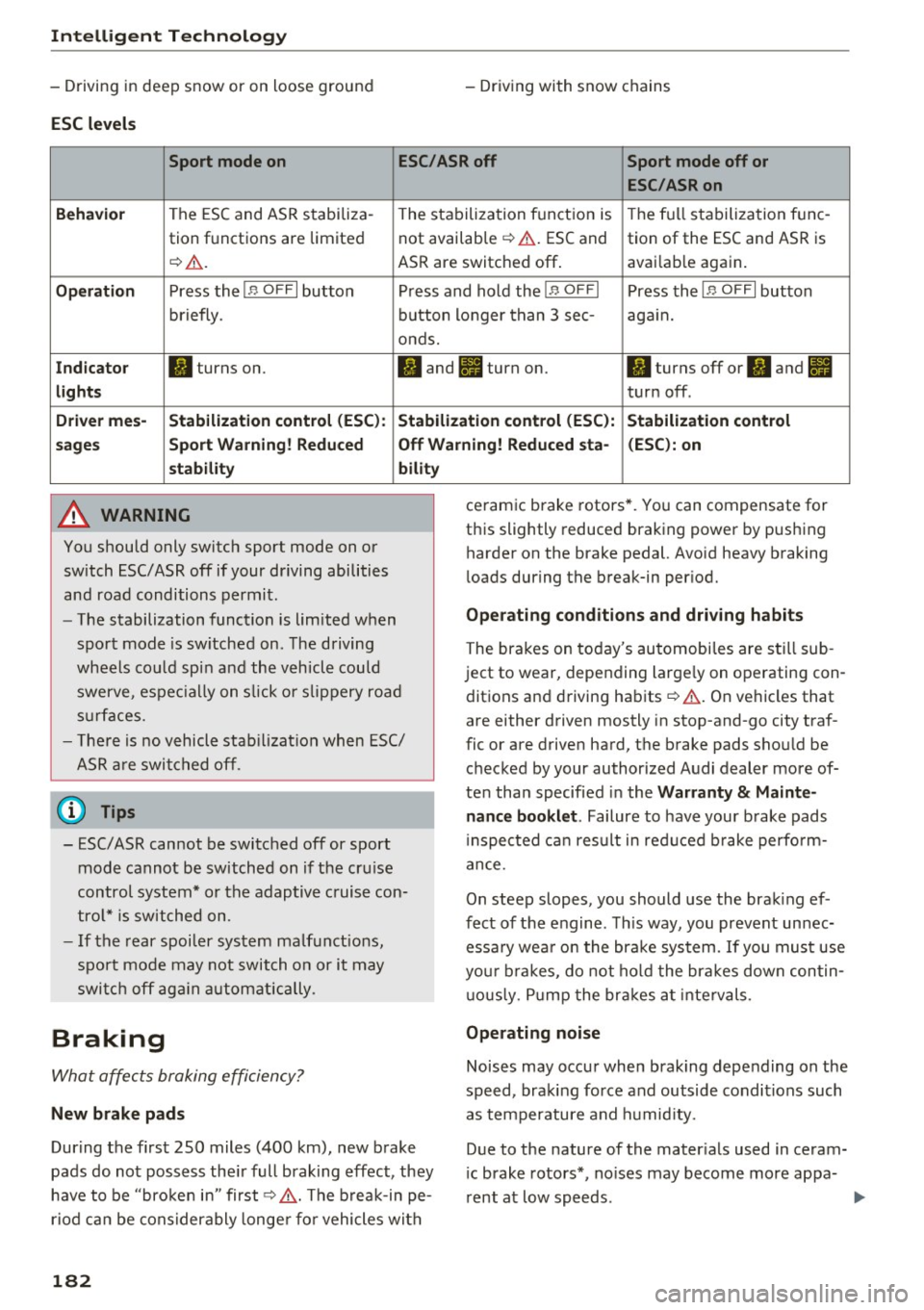
Intelligent Technology
- Driving in deep snow or on loose ground
ESC levels
- Driv ing with snow chains
Sport mode on ESC/ASR off Sport mode off or
ESC/ASRon
Beha vior
The ESC and ASR stabiliza- The stabiliza tion function is The f ull stabilization tune-
tion f unctions are limited not available ¢
,&. ESC and
tion of the ESC and ASR is
¢
&. . ASR are switched off . avai
lab le aga in .
Op eration Press the I B OFF I button Press and hold the !B OFFI Press the IB OFFI button
briefly . button longer than 3 sec- again.
onds.
I n d ica to r II turns on. II and lit turn on. II turns off or II and II
light s turn off .
Driver me s- Stabili zation cont rol (E SC): S tabilization control (E SC ):
Stabili zation cont rol
s age s Sport Warning ! Redu ced Off Wa
rning! Reduced sta - (ESC ): on
st abilit y
A WARNING
You should only switch sport mode on or
switch ESC/ ASR off if your driving abilities
and road conditions permit.
bility
- The stabilization function is limited when
sport mode is sw itched on. The driving
wheels co uld spin and the vehicle could
swerve , espec ially on s lick o r slippery road
s u rfaces.
- The re is no vehicle stab ilizat ion when ESC/
ASR a re swi tched off .
(D Tips
-ESC/ASR cannot be switched off or sport
mode cannot be switched on if the cru ise
control system* or the adaptive cruise con
tro l* is switched on .
- If the rear spoiler system malfunct ions,
sport mode may not switch on or it may switch off ag ain automatically .
Braking
What affects braking efficiency?
New brake pads
During the first 250 miles (400 km), new brake
pads do not possess the ir full braking effect, they
have to be "broken in" first¢&, . The b reak-in pe
riod can be considerably longe r fo r vehicles with
182
ceramic brake rotors* . You can compensate for
this slightly reduced braking power by pushing harder on the brake pedal. Avoid heavy braking
l oads during the break-in per iod.
Op erating c ondition s and dri ving habits
The brak es on today 's automobiles are still sub
ject to wear, depending large ly on operating con
dit ions and driving habits ¢&, . On vehicles that
are either driven mostly in stop-and-go city traf
fic or are driven hard, the brake pads shou ld be
checked by your authorized Audi dealer more of
ten than specified in the
Warr ant y & Maint e
nance booklet .
Failure to have your brake pads
i nspected ca n result in red uced b rake perfo rm
ance.
On steep slopes, you should use the brak ing ef
fect of the engine . Th is way, you prevent unnec
essa ry wea r on the brake system. If you must use
you r brakes, do not ho ld the brakes down contin
u ous ly. P ump the brakes at intervals.
Operating noi se
Noises may occur when brak ing depending on the
speed, braking force and outside conditions such as temperature and h umid ity.
Due to the nature of the mater ials used in ceram
i c brake rotors*, no ises may become more appa-
rent at low speeds. ..,.
Page 187 of 282
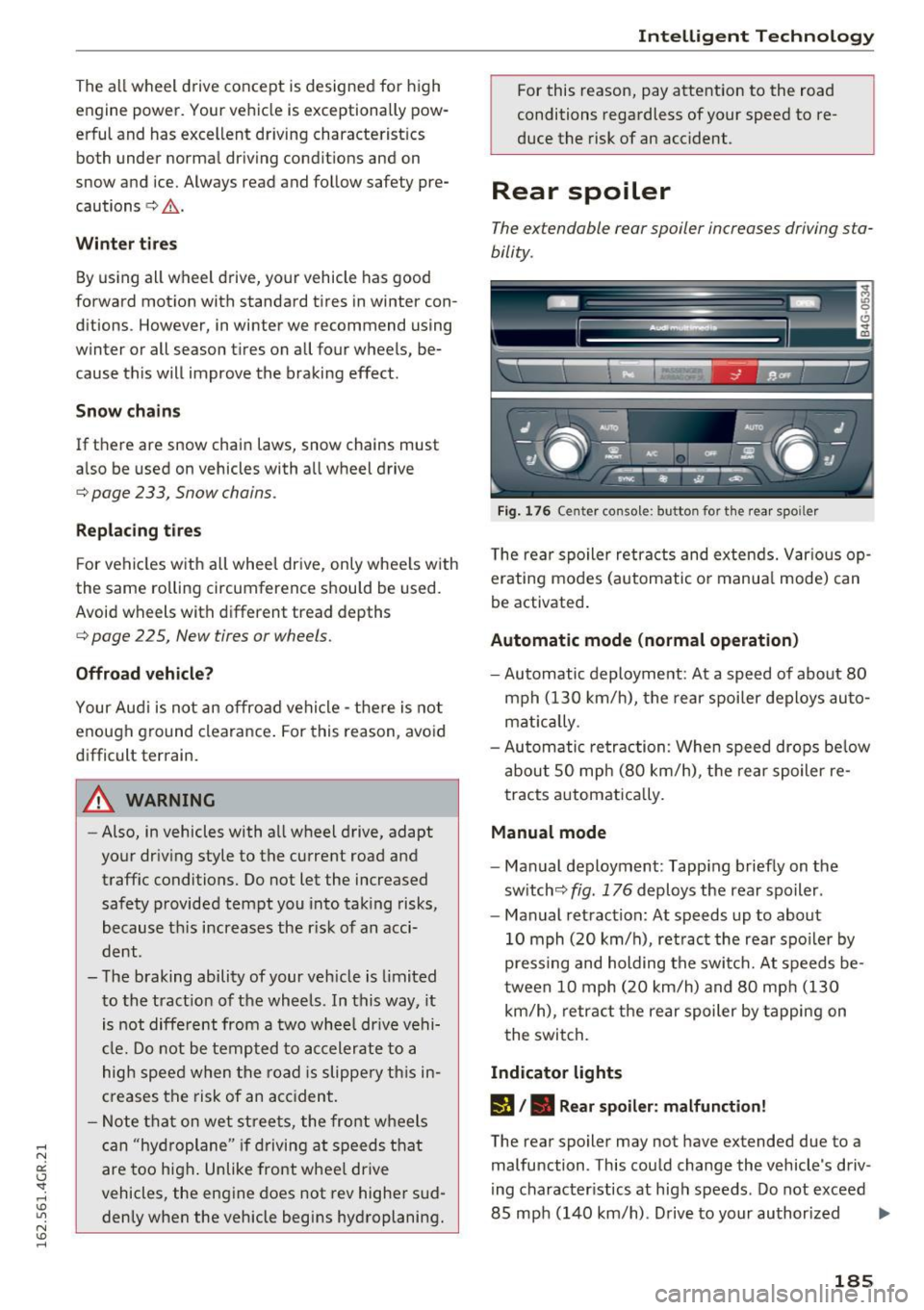
The all wheel drive concept is designed for high
engine power. Your vehicle is exceptionally pow
erful and has excellent driving characterist ics
both under normal driving conditions and on
snow and ice. Always read and follow safety pre
cautions
¢ ,&. .
Winter tires
By using all wheel drive, your vehicle has good
forward motion with standard tires in winter con ditions . However, in winter we recommend using
winter or all season tires on all four wheels, be
cause this will improve the braking effect.
Snow chains
If there are snow chain laws, snow chains must
also be used on vehicles with all wheel drive
¢ page 233, Snow chains .
Replacing tires
For vehicles with all wheel drive, only wheels with
the same rolling circumference should be used .
Avoid wheels with different tread depths
¢ page 225, New tires or wheels.
Offroad vehicle?
Your Audi is not an offroad vehicle -there is not
enough ground clearance. For this reason, avoid
difficult terrain.
A WARNING
-Also, in vehicles with all wheel drive, adapt
your driving style to the current road and
traffic conditions. Do not let the increased
safety provided tempt you into taking risks,
because th is increases the r isk of an acci
dent.
- The braking ability of your veh icle is limited
to the tract ion of the wheels . In this way, it
is not diffe rent from a two wheel drive vehi
cle. Do not be tempted to accelerate to a
high speed when the road is slippery this in
creases the risk of an accident.
- Note that on wet streets, the front wheels
can "hydroplane" if driving at speeds that
are too high . Unlike front wheel drive
vehicles, the engine does not rev higher sud
denly when the vehicle begins hydroplaning.
Intelligent Technology
For this reason, pay attention to the road
conditions reg a rd less of your speed to re
duce the risk of an accident .
Rear spoiler
The extendable rear spoiler increases driving sta
bility .
Fig. 176 Center console: button for t he rear spoiler
The rear spoiler retracts and extends. Var ious op
erating modes (automatic or manua l mode) can
be activated .
Automatic mode (normal operation)
-Automatic deployment : At a speed of about 80
mph (130 km/h), the rear spoiler deploys auto
mat ically .
- Automatic retraction: When speed drops be low
about SO mph (80 km/h), the rear spoiler re
tracts automatically.
Manual mode
-Manual deployment: Tapping briefly on the
switch<=:>
fig. 176 deploys the rear spoiler.
- Manual retraction: At speeds up to about
10 mph (20 km/h), retract the rear spoiler by
pressing and holding the switch. At speeds be
tween 10 mph (20 km/h) and 80 mph (130
km/h), retract the rear spoiler by tapping on
the switch.
Indicator lights
l'J /. Rear spoiler: malfunction!
The rear spoiler may not have extended due to a
malfunction . This could change the vehicle's driv
ing character istics at high speeds . Do not exceed
85 mph (140 km/h). Drive to your authorized ..,.
185
Page 235 of 282
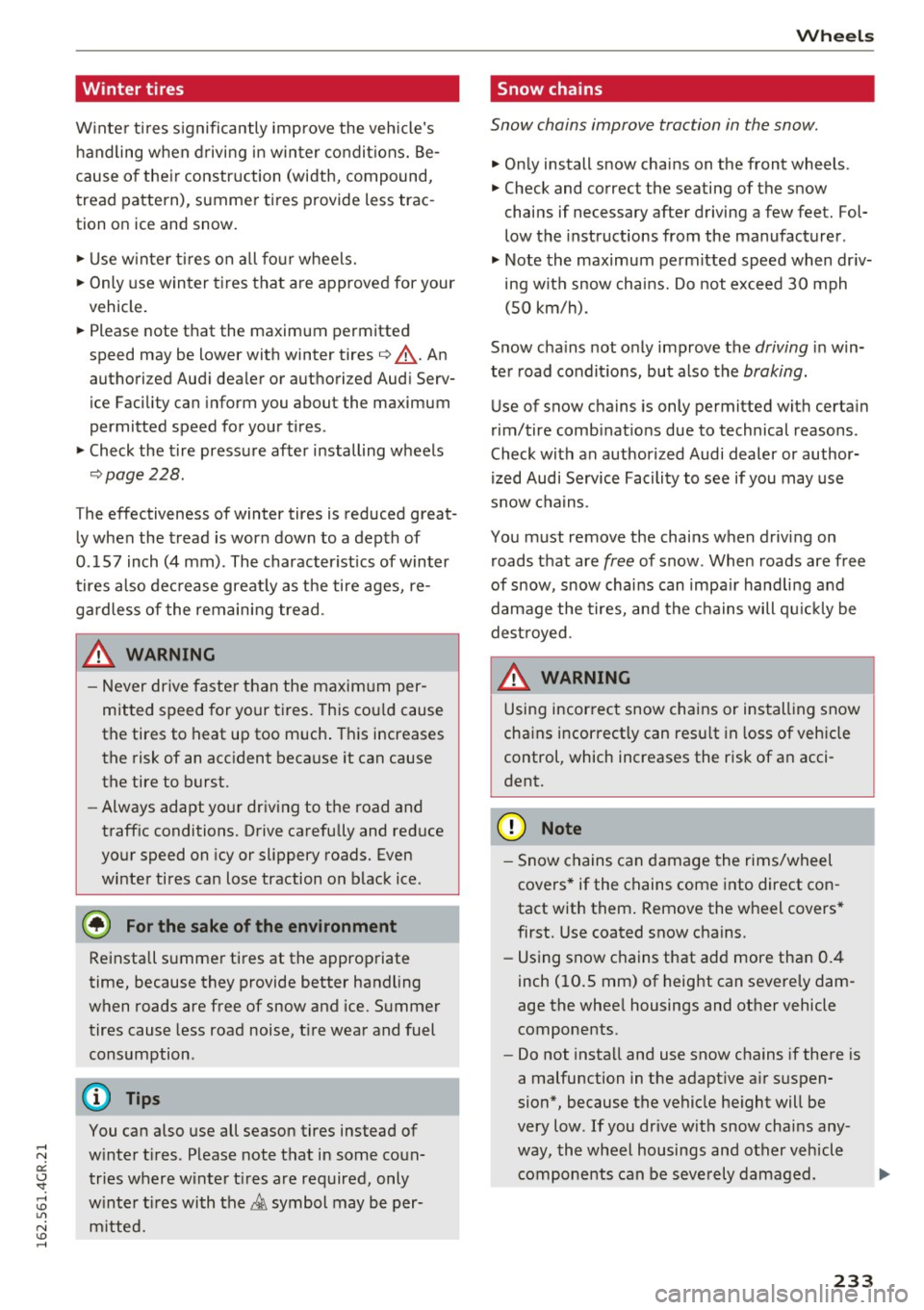
Winter tires
Winte r ti res s ignificantly improve the veh icle's
handling when driving in winter condit ions. Be
cause of the ir construction (width, compound,
tread pattern), summer tires provide less trac
tion o n ice and snow.
,.. Use w inter t ires on all fo ur wheels.
,.. Only use winter t ires that are approved for your
vehicle.
,.. Please note that the maximum permitted
speed may be lower with winter tires
9 &, . An
authorized Audi dealer or authorized Audi Serv
ice Facility can inform you about the maximum
permitted speed for your tires.
,.. Check the tire press ure after installing wheels
9page 228.
The effectiveness of winter tires is reduced great
ly when the tread is worn down to a depth of
0 .1 57 inch (4 mm). The character istics of winter
tires a lso dec rease great ly as the tire ages, re
ga rdless of the remaining tread.
_& WARNING
- Never drive faster than the maxim um per
mitted speed for your tires. This cou ld cause
the tires to heat up too much . Th is increases
the risk of an accident because it can cause
the tire to burst.
- Always adapt your dr iv ing to the road and
traff ic conditions. Drive carefully and reduce
your speed on icy or slippery roads. Even
winter tires can lose traction on black ice.
@ For the sake of the environment
Reinstall summer ti res at the appropriate
time, because they provide better handling
when roads are free of snow and ice. Summer tires cause less road noise, t ire wear and fuel
consumption.
You ca n also use all season tires instead of
w inter t ires. Please note that in some coun
tries where w inter t ires are required, only
w inter t ires with the
& symbol may be per
m itted.
-
Wh eel s
Snow chains
Snow chains improve traction in the snow .
,.. On ly install snow chains on the front wheels.
,.. Check and correct the seating of the snow
chains if necessary after driving a few feet. Fol
low the instruct ions from the manufacturer.
,.. Note the maximum permitted speed when dr iv
ing wit h snow chains. Do not exceed 30 mph
(SO km/h) .
Snow cha ins not o nly improve the
driving in win
te r road condit ions, but also the
braking.
Use of snow chains is only permitted with certa in
rim/tire comb inat ions due to technical reasons.
Check with an authorized Audi dealer or author
ized Audi Service Facili ty to see if you may use
snow c ha ins.
You must remove the chains when driving on roads that are
free of snow . When roads are free
of snow, snow chai ns can impa ir handling and
damage the tires, and the chains will qu ic kl y be
dest royed.
_& WARNING ~
Using incorrect snow chains or ins tall ing snow
chains incorrect ly can resu lt in loss of veh icle
control, which increases the risk of a n acci
dent.
(D Note
- Snow chains can damage the rims/wheel
covers* if the chains come into direct con
tact with them . Remove the wheel covers*
first. Use coated snow chains.
- Using snow c hains that add more than 0.4
inch ( 10.5 mm) of height can severely dam
age the whee l housings and other vehicle
components.
- Do not insta ll and use snow chains if there is
a malfunction in the adapt ive a ir suspen
sion*, because the vehicle he ight will be
very low. If you drive with snow chains any
way, the wheel housings and other vehicle
components can be seve rely damaged.
233
Page 236 of 282
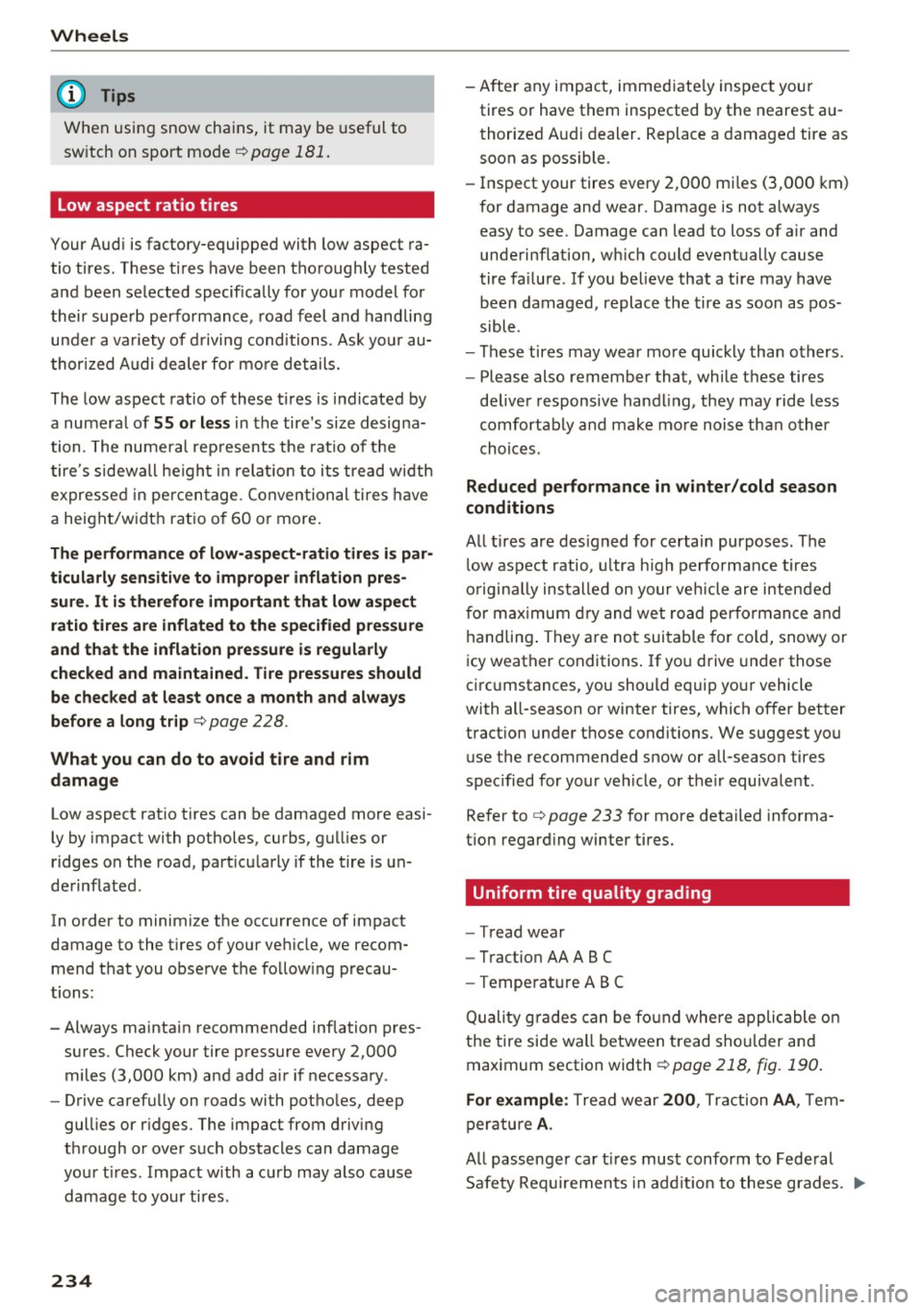
Wheels
(D Tips
When using snow chains, it may be useful to
sw itch on sport mode
¢ page 181.
Low aspect ratio tires
Your Aud i is factory-equipped with low aspect ra
tio tires. These tires have been thoroughly tested
and been selected specifically for your model fo r
thei r supe rb perfo rmance, road feel and handling
unde r a va riety of d riving conditions . As k yo ur au
thor ized Audi dealer for mo re de tails.
The low aspect ratio of these t ires is indicated by
a nume ra l of
55 or less in the tire's size desig na
tion . The nume ra l rep resents the rat io of t he
tire 's sidewall he igh t in relat io n t o it s tread w idth
e xpresse d in percen tage. Convention al ti res have
a height/w idth ratio o f 60 o r more .
The performance of low -aspect-ratio tires is par
ticularly sensitive to improper inflation pres
sure. It is therefore important that low a spect
ratio tires are inflated to the specified pre ssure
and that the inflation pressure is regularly
checked and maintained. Tire pressures should
be checked at le ast once a month and alwa ys
before a long trip¢
page 228.
What you can do to avoid tire and rim
damage
Low aspect rat io tires can be damaged more easi
ly by impact with potholes, curbs, gullies or
ridges on the road, pa rt icu la rly if the t ire is un
de rinflated.
In order to minimize the occurrence of impact
damage to the t ires of your ve hicle, we recom
mend that you observe the fo llow ing precau
tions:
- Always maintain recommended inflation pres
su res . Check your tire pressure every 2,000
miles (3,000 km) and add air if necessary .
- Drive caref ully on roads with potho les, deep
gul lies or r idges . The impact from drivi ng
through or over s uch obstacles can damage
you r tires. Im pact with a cu rb may also cause
damage to you r tires .
234
-After any impact, immed iate ly inspect you r
tires or have them inspected by the nearest au
thorized Aud i dealer. Replace a damaged tire as
soon as possible.
- Ins pect your tires every 2,000 mi les (3,000 km)
for damage and wear . Damage is not always
easy to see . Damage can lead to loss of a ir and
underinfla tion, w hich could even tua lly cause
tire fa ilure . If yo u be lieve that a tire may have
been damaged, replace the tire as soon as pos
sible.
- These tires may wear mo re quickly than others .
- Please also remember that, while t hese tires
delive r responsive hand ling, they may ride less
comforta bly and make mo re noise than o ther
choi ces.
Reduced performance in winter/cold season
conditions
A ll ti res are des igned for certain purposes. The
l ow aspect ratio, ultra h igh performance tires
o rigina lly ins talled on your veh icle are inten ded
f o r m ax imu m dr y and wet ro ad perfo rma nce and
handling . They a re not sui table for co ld, snowy or
i cy weather conditions . If yo u drive under those
c ir cu mstances, you should equip yo ur vehicle
with all-season o r winter tires, which offer better
tract ion under t hose conditions. We suggest you
use the recommended snow or a ll-season tires
spec ified for your vehicle, o r th e ir equiva le nt.
Re fer to
c:> page 233 for more detailed in forma
tion regard ing winter tires.
Uniform tire quality grading
- Tread wea r
- Tract io n AA AB C
- Tempe rature ABC
Quali ty g rades can be fo und whe re appli cab le on
t h e tire side wall between tread shou lder and
max imum section width
¢ page 218, fig. 190 .
For example : Tread wear 200 , Traction AA , Tem
per atu re
A .
All passenge r ca r tir es mus t conform to Fede ral
Safety Req uiremen ts in add it io n to these grades . ..,.
Page 277 of 282
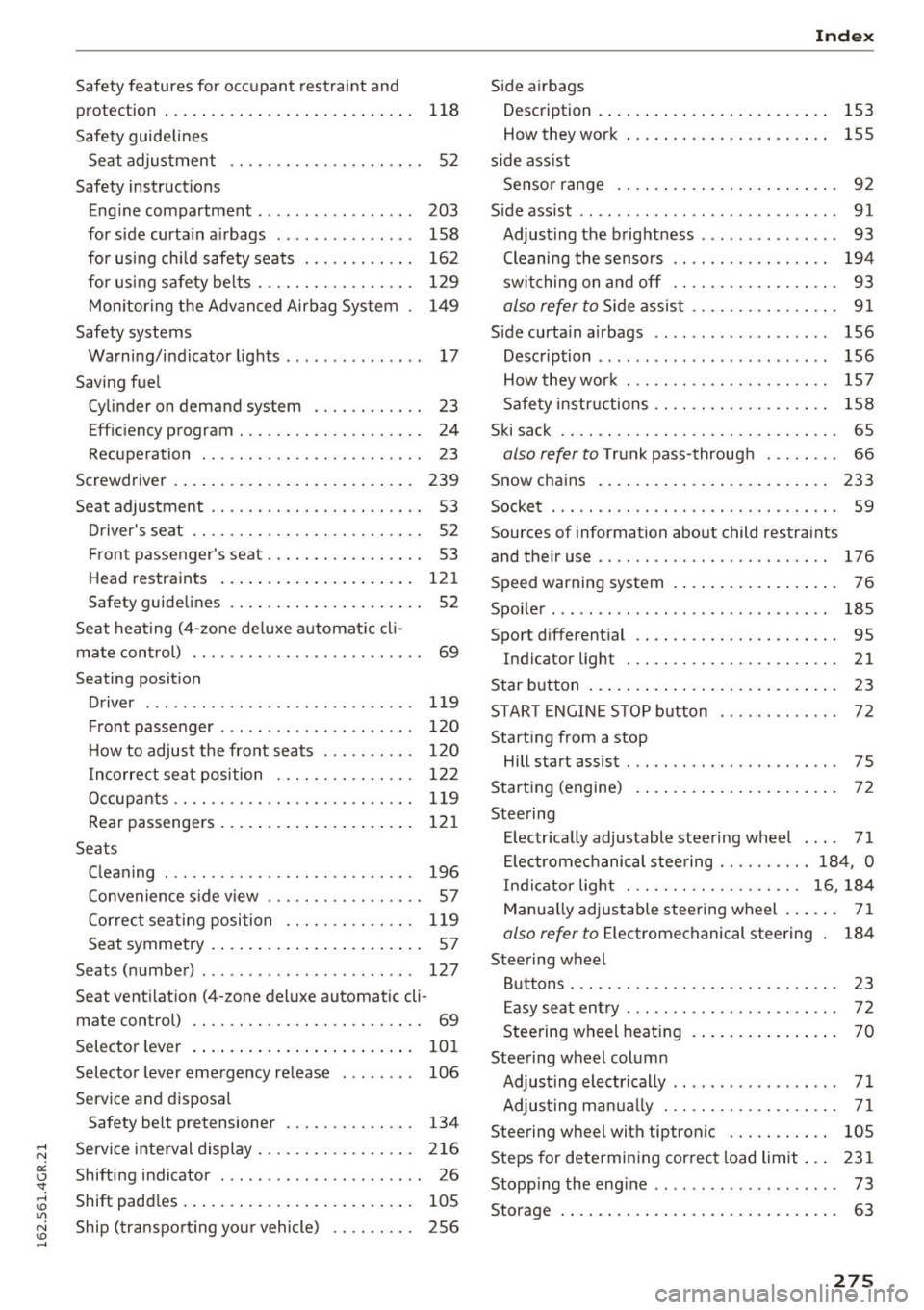
Safety features for occupant restraint and
protection . . . . . . . . . . . . . . . . . . . . . . . . . . . 118
Safety guidelines
Seat adjustment . . . . . . . . . . . . . . . . . . . . . S2
Safety instructions Eng ine compartment . . . . . . . . . . . . . . . . . 203
for side curtain airbags . . . . . . . . . . . . . . . 158
for using chi ld safety seats . . . . . . . . . . . . 162
for using safety belts . . . . . . . . . . . . . . . . . 129
Monitoring the Advanced Airbag System . 149
Safety systems Warning/indicator lights . . . . . . . . . . . . . . . 17
Saving fuel Cylinder on demand system . . . . . . . . . . . . 23
Efficiency program . . . . . . . . . . . . . . . . . . . . 24
Recuperation . . . . . . . . . . . . . . . . . . . . . . . . 23
Screwdriver . . . . . . . . . . . . . . . . . . . . . . . . . . 239
Seat adjustment . . . . . . . . . . . . . . . . . . . . . . . 53
Driver's seat . . . . . . . . . . . . . . . . . . . . . . . . . 52
Fr ont passenger's seat . . . . . . . . . . . . . . . . . S3
Head restraints . . . . . . . . . . . . . . . . . . . . . 121
Safety guidelines . . . . . . . . . . . . . . . . . . . . . 52
Seat heating (4-zone deluxe automat ic cli-
mate control) . . . . . . . . . . . . . . . . . . . . . . . . . 69
Seating position Driver . . . . . . . . . . . . . . . . . . . . . . . . . . . . . 119
Front passenger . . . . . . . . . . . . . . . . . . . . . 120
How to adjust the front seats . . . . . . . . . . 120
I ncorrect seat position . . . . . . . . . . . . . . . 122
Occupants .. .. .. ........... .. .. .. ... 119
Rear passengers . . . . . . . . . . . . . . . . . . . . . 121
Seats Cleaning . . . . . . . . . . . . . . . . . . . . . . . . . . . 196
Convenience s ide view . . . . . . . . . . . . . . . . . 57
Correct seating position . . . . . . . . . . . . . . 119
Seat symmetry . . . . . . . . . . . . . . . . . . . . . . . 57
Seats (number) . . . . . . . . . . . . . . . . . . . . . . . 127
Seat ventilation (4-zone deluxe automatic cli mate control) . . . . . . . . . . . . . . . . . . . . . . . . . 69
Selecto r lever . . . . . . . . . . . . . . . . . . . . . . . . 101
Selector lever emergency release . . . . . . . . 106
Service and disposal
Safety belt pretensioner . . . . . . . . . . . . . . 134
Service interval display.......... .. .. .. . 216
Shifting indicator . . . . . . . . . . . . . . . . . . . . . . 26
Shift paddles . . . . . . . . . . . . . . . . . . . . . . . . . 105
~ Ship (transporting your vehicle) . . . . . . . . . 256
......
Index
Side airbags
Description . . . . . . . . . . . . . . . . . . . . . . . . . 153
How they work . . . . . . . . . . . . . . . . . . . . . . 155
s ide ass ist
Sensor range . . . . . . . . . . . . . . . . . . . . . . . . 92
Side assist . . . . . . . . . . . . . . . . . . . . . . . . . . . . 91
Adjusting the brightness . . . . . . . . . . . . . . . 93
Cleaning the sensors . . . . . . . . . . . . . . . . . 194
switching on and off . . . . . . . . . . . . . . . . . . 93
also refer to Side assist . . . . . . . . . . . . . . . . 91
Side curtain airbags . . . . . . . . . . . . . . . . . . . 156
Description . . . . . . . . . . . . . . . . . . . . . . . . . 156
How they work . . . . . . . . . . . . . . . . . . . . . . 157
Safety instructions . . . . . . . . . . . . . . . . . . . 158
Ski sack . . . . . . . . . . . . . . . . . . . . . . . . . . . . . . 65
also refer to Trunk pass -through . . . . . . . . 66
Snow chains . . . . . . . . . . . . . . . . . . . . . . . . . 233
Socket . . . . . . . . . . . . . . . . . . . . . . . . . . . . . . . 59
Sources of information about child restraints
and their use . . . . . . . . . . . . . . . . . . . . . . . . . 176
Speed warning system . . . . . . . . . . . . . . . . . . 76
Spoi ler . . . . . . . . . . . . . . . . . . . . . . . . . . . . . . 185
Sport differential . . . . . . . . . . . . . . . . . . . . . . 95
Indicator light . . . . . . . . . . . . . . . . . . . . . . . 21
Star button . . . . . . . . . . . . . . . . . . . . . . . . . . . 23
START ENGINE STOP button . . . . . . . . . . . . . 72
Starting from a stop Hill start assist . . . . . . . . . . . . . . . . . . . . . . . 75
Starting (engine) . . . . . . . . . . . . . . . . . . . . . . 72
Steering Electrically adjustable steering wheel . . . . 71
Electromechanical steering .......... 184 , 0
Indicator light . . . . . . . . . . . . . . . . . . . 16, 184
Manua lly adjustable steering wheel . . . . . . 71
also refer to Electromechanical steering . 184
Steering wheel Buttons. .. .... .. .. ............... .. . 23
Easy seat entry . . . . . . . . . . . . . . . . . . . . . . . 72
Steering wheel heating . . . . . . . . . . . . . . . . 70
Steering wheel column Adjusting electrically . . . . . . . . . . . . . . . . . . 71
Adjusting manually . . . . . . . . . . . . . . . . . . . 71
Steering wheel with tiptronic . . . . . . . . . . . 105
Steps for determining correct load limit.. . 231
Stopping the engine . . . . . . . . . . . . . . . . . . . . 73
Storage . . . . . . . . . . . . . . . . . . . . . . . . . . . . . . 63
275
Page 279 of 282
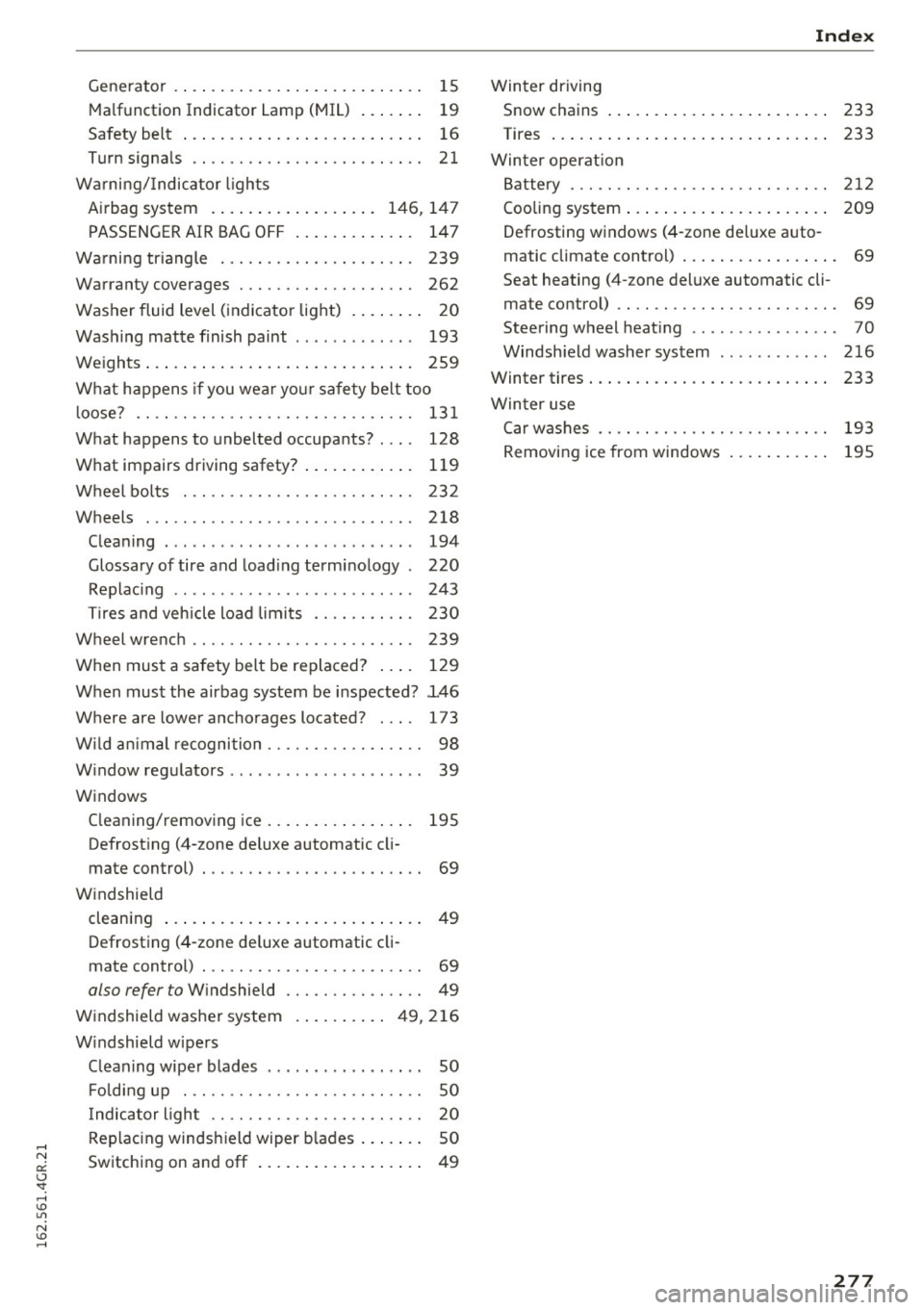
Generator . . . . . . . . . . . . . . . . . . . . . . . . . . . 15
Malfunction Indicator Lamp (MIL) . . . . . . . 19
Safety belt . . . . . . . . . . . . . . . . . . . . . . . . . . 16
Turn signals . . . . . . . . . . . . . . . . . . . . . . . . . 21
Warning/Indicator lights
Airbag system . . . . . . . . . . . . . . . . . . 146, 147
PASSENGER AIR BAG OFF . . . . . . . . . . . . . 147
Warning tr iangle . . . . . . . . . . . . . . . . . . . . . 239
Warranty coverages . . . . . . . . . . . . . . . . . . . 262
Washer fluid level (indicator light) . . . . . . . . 20
Washing matte finish paint . . . . . . . . . . . . . 193
Weights . . . . . . . . . . . . . . . . . . . . . . . . . . . . . 259
What happens if you wear your safety belt too
l oose? . . . . . . . . . . . . . . . . . . . . . . . . . . . . . . 131
What happens to unbelted occupants? . . . . 128
What impairs driving safety? . . . . . . . . . . . . 119
Wheel bolts . . . . . . . . . . . . . . . . . . . . . . . . . 232
Wheels . . . . . . . . . . . . . . . . . . . . . . . . . . . . . 218
Cleaning . . . . . . . . . . . . . . . . . . . . . . . . . . . 194
Glossary of tire and loading terminology . 220
Replacing . . . . . . . . . . . . . . . . . . . . . . . . . . 243
Tires and vehicle load limits . . . . . . . . . . . 230
Wheel wrench . . . . . . . . . . . . . . . . . . . . . . . . 239
When must a safety belt be replaced? . . . . 129
When must the airbag system be inspected? l46
Where are lower anchorages located? . . . . 173
W ild animal recognition . . . . . . . . . . . . . . . . . 98
Window regulators . . . . . . . . . . . . . . . . . . . . . 39
Windows Cleaning/removing ice . . . . . . . . . . . . . . . . 195
Defrosting (4-zone deluxe automatic cli-
mate control) . . . . . . . . . . . . . . . . . . . . . . . . 69
Windshield cleaning . . . . . . . . . . . . . . . . . . . . . . . . . . . . 49
Defrosting (4-zone deluxe automatic cli-
mate control) . . . . . . . . . . . . . . . . . . . . . . . . 69
also refer to Windshield . . . . . . . . . . . . . . . 49
Windshield washer system . . . . . . . . . . 49, 216
Windshield wipers Cleaning wiper blades . . . . . . . . . . . . . . . . . SO
Folding up . . . . . . . . . . . . . . . . . . . . . . . . . . SO
I ndicator light . . . . . . . . . . . . . . . . . . . . . . . 20
Replacing windshield wiper blades . . . . . . . 50
Switching on and
off . . . . . . . . . . . . . . . . . . 49
Index
Winter driving
Snow chains . . . . . . . . . . . . . . . . . . . . . . . . 233
Tires . . . . . . . . . . . . . . . . . . . . . . . . . . . . . . 233
Winter operation
Battery . . . . . . . . . . . . . . . . . . . . . . . . . . . . 212
Cooling system . . . . . . . . . . . . . . . . . . . . . . 209
Defrosting windows (4-zone deluxe auto-
matic climate control) . . . . . . . . . . . . . . . . . 69
Seat heating (4-zone deluxe automatic cli- mate control) . . . . . . . . . . . . . . . . . . . . . . . . 69
Steering wheel heating . . . . . . . . . . . . . . . . 70
Windsh ield washer system . . . . . . . . . . . . 216
Winter tires . . . . . . . . . . . . . . . . . . . . . . . . . . 233
Winter use Car washes . . . . . . . . . . . . . . . . . . . . . . . . . 193
Removing ice from windows . . . . . . . . . . . 195
277